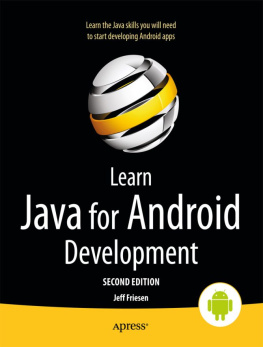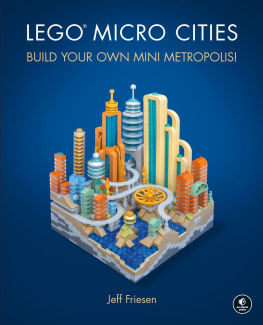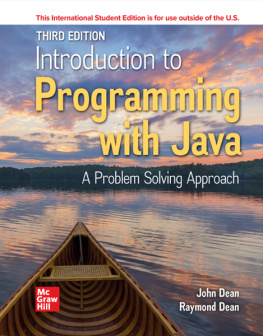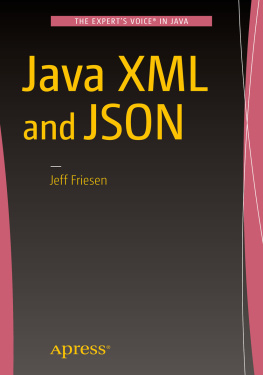We offer to read an annotation, description, summary or preface (depends on what the author of the book "Beginning Java 7" wrote himself). If you haven't found the necessary information about the book — write in the comments, we will try to find it.
Beginning Java 7 guides you through this language and a huge assortment of platform APIs according to the following table of contents: Chapter 1: Getting Started with Java Chapter 2: Discovering Classes and Objects Chapter 3: Exploring Advanced Language Features Chapter 4: Touring Language APIs Chapter 5: Collecting Objects Chapter 6: Touring Additional Utility APIs Chapter 7: Creating and Enriching Graphical User Interfaces Chapter 8: Interacting with Filesystems Chapter 9: Interacting with Networks and Databases Chapter 10: Parsing, Creating, and Transforming XML Documents Chapter 11: Working with Web Services Chapter 12: Java 7 Meets Android Appendix A: Solutions to Exercises Appendix B: Scripting API and Dynamically Typed Language Support Appendix C: Odds and Ends Appendix D: Applications Gallery Chapter 1 introduces you to Java and begins to cover the Java language by focusing on fundamental concepts such as comments, identifiers, variables, expressions, and statements. Chapter 2 continues to explore this language by presenting all of its features for working with classes and objects. You learn about features related to class declaration and object creation, encapsulation, information hiding, inheritance, polymorphism, interfaces, and garbage collection. Chapter 3 focuses on the more advanced language features related to nested classes, packages, static imports, exceptions, assertions, annotations, generics, and enums. Additional chapters will introduce you to the few features not covered in Chapters 1 through 3. Chapter 4 largely moves away from covering language features (although it does introduce class literals and strictfp) while focusing on language-oriented APIs. You learn about Math, StrictMath, Package, Primitive Type Wrapper Classes, Reference, Reflection, String, StringBuffer and StringBuilder, Threading, BigDecimal, and BigInteger in this chapter. Chapter 5 begins to explore Javas utility APIs by focusing largely on the Collections Framework. However, it also discusses legacy collection-oriented APIs and how to create your own collections. Chapter 6 continues to focus on utility APIs by presenting the concurrency utilities along with the Objects and Random classes. Chapter 7 moves you away from the command-line user interfaces that appear in previous chapters and toward graphical user interfaces. You first learn about the Abstract Window Toolkit foundation, and then explore the Java Foundation Classes in terms of Swing and Java 2D. Appendix C explores Accessibility and Drag and Drop. Chapter 8 explores filesystem-oriented I/O in terms of the File, RandomAccessFile, stream, and writer/reader classes. New I/O is covered in Appendix C. Chapter 9 introduces you to Javas network APIs, such as sockets. It also introduces you to the JDBC API for interacting with databases. Chapter 10 dives into Javas XML support by first presenting an introduction to XML (including DTDs and schemas). It next explores the SAX, DOM, StAX, XPath, and XSLT APIs. It even briefly touches on the Validation API. While exploring XPath, you encounter namespace contexts, extension functions and function resolvers, and variables and variable resolvers. Chapter 11 introduces you to Javas support for SOAP-based and RESTful web services. In addition to providing you with the basics of these web service categories, Chapter 11 presents some advanced topics, such as working with the SAAJ API to communicate with a SOAP-based web service without having to rely on JAX-WS. You will appreciate having learned about XML in Chapter 10 before diving into this chapter. Chapter 12 helps you put to use some of the knowledge youve gathered in previous chapters by showing you how to use Java to write an Android apps source code. This chapter introduces you to Android, discusses its architecture, shows you how to install necessary tools, and develops a simple app. Appendix A presents the solutions to the programming exercises that appear near the end of Chapters 1 through 12. Appendix B introduces you to Javas Scripting API along with Java 7s support for dynamically typed languages. Appendix C introduces you to additional APIs and architecture topics: Accessibility, ByteArrayOutputStream and ByteArrayInputStream, classloaders, Console, Desktop, Drag and Drop, Dynamic Layout, Extension Mechanism and ServiceLoader, File Partition-Space, File Permissions, Formatter, Image I/O, Internationalization, Java Native Interface, NetworkInterface and InterfaceAddress, New I/O (including NIO.2), PipedOutputStream and PipedInputStream, Preferences, Scanner, Security, Smart Card, Splash Screen, Stream Tokenizer, StringTokenizer, SwingWorker, System Tray, Timer and TimerTask, Tools and the Compiler API, Translucent and Shaped Window, and XML Digital Signature. Appendix D presents a gallery of significant applications that demonstrate various aspects of Java. Unfortunately, there are limits to how much knowledge can be crammed into a print book. For this reason, Appendixes A, B, C, and D are not included in this books pages. Instead, these appendixes are freely distributed as PDF files. Appendixes A and B are bundled with the books associated code file at the Apress website (http://www.apress.com). Appendixes C and D are bundled with their respective code files on my TutorTutor.ca website at http://tutortutor.ca/cgi-bin/makepage.cgi?/books/bj7. Appendixes C and D are living documents in that Ill occasionally add new material to them. For example, I plan to expand Appendix C by also covering Java Naming and Directory Interface, Java Sound, Remote Method Invocation and Corba, Robot, Runtime and Process, Swing Timer, and many other APIs/architecture topics (including a complete tour of Swing components). Of course, it will take time to write about these topics so dont expect all of them to appear at once -- they will slowly emerge in coming months (although smaller topics such as Robot will emerge much faster). What youll learn The entire Java language, including Java 7-specific features such as switch on string, try-with-resources, final rethrow, multicatch, and SafeVarargs A huge assortment of Java 7 APIs, beginning with those APIs oriented toward the language itself, and including Java 7-specific APIs such as the Fork/Join Framework, Objects, JLayer, and NIO.2 Various Java 7 tools, starting with the javac compiler and java application launcher How to create user interfaces, working with web services, and a whole lot more The basics of getting started with Android app development Who this book is forThis book targets the following groups of developers: Newcomers, skilled (to some degree) in other programming languages but with no previous exposure to Java Intermediate Java developers, skilled in the fundamentals of Java prior to Java 7 and looking to increase their understanding of Java 7 language/API changes All developers looking beyond standard Java, who want to leverage Java 7 to create mobile apps via Android Even advanced Java developers may find a few items of interest Table of Contents Getting Started with Java Discovering Classes and Objects Exploring Advanced Language Features Touring Language and Utility APIs Collecting Objects Touring Additional Utility APIs Creating and Enriching Graphical User Interfaces Interacting with Filesystems Interacting with Networks and Databases Parsing, Creating, and Transforming XML Documents Working with Web Services Java 7 Meets Android










![Jeff Friesen [Jeff Friesen] - Java XML and JSON: Document Processing for Java SE](/uploads/posts/book/124064/thumbs/jeff-friesen-jeff-friesen-java-xml-and-json.jpg)

